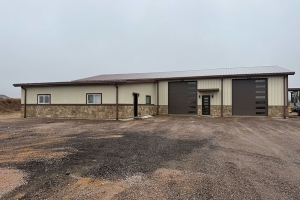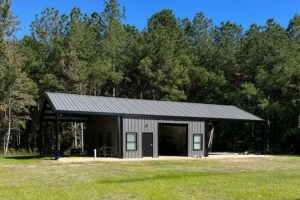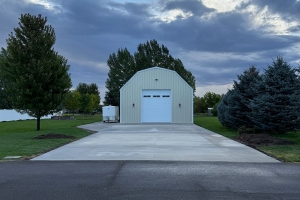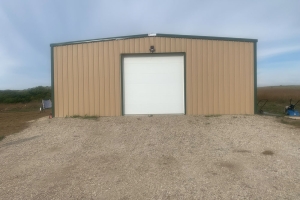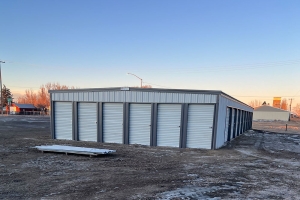Considerations for Your Steel Airplane Hangar Design
October 4, 2024 | Aircraft Hangars
When you’re looking for an airplane hangar design, there are many factors to consider. Although functionality is of utmost importance, aesthetic considerations also play a role in choosing the right design. A hangar that fails to meet any of these requirements is likely to cost you more in the long run, so it’s important to do your research and make an informed decision. The following guide will cover the key considerations when planning for your hangar design to help ensure that it meets all of your needs.
Key Considerations When Choosing An Aircraft Hangar Design
When it comes to designing an aircraft hangar, several customization options are available. At Sunward Steel, you can customize your aircraft hangar with various features, including insulation, doors, interior and exterior facades, wainscotting, windows, skylights, LED lighting, and more.
How you customize your hangar will significantly impact the overall cost and timeline for construction. Therefore, you’ll want to carefully consider each option and determine what will fit your needs best. The following are some of the crucial considerations that you should keep in mind when designing your hangar.
1. Budget and Size
The size of your airplane hangar should be determined by several factors, including the type and size of aircraft it will accommodate. There’s a big difference between storing a single-engine plane and a massive jumbo jet. Not only will the building need to be taller and wider to fit a bigger aircraft, but you’ll also need larger, more durable doors to allow larger airplanes to enter and exit. You should also consider the number of aircraft you plan to house at any given time, as this will affect how much hangar space is needed.
The size of your hangar is critical to calculate since the larger the hangar, the more expensive it will be to build and maintain. Therefore, the first thing you should do is identify how big you need your hangar to be and what your budget is. Once you’ve calculated these, you can consider any customization options for your hangar.
2. Structural Considerations
When deciding on the structural considerations for your hangar design, there are many applications to choose from including steel, wood, and sometimes concrete. Generally speaking, metal hangars are superior to other applications. This is because steel hangars provide greater strength and require minimal maintenance over time.
Furthermore, metal aircraft hangars can be prefabricated, meaning they are manufactured in a factory and then shipped to the site for assembly. As a result, they are more cost-effective and require much less labor to construct. In addition, the materials are less expensive since they don’t have to be sourced and shipped from multiple vendors.
Durability And Corrosion Protection
Aircraft hangars require regular maintenance to keep them in good condition and ensure they last as long as possible. Steel aircraft hangars are much more durable than their counterparts, making them ideal for areas with harsh weather conditions. Traditional construction materials are more susceptible to wear and tear from the elements, while steel is known to better withstand extreme temperatures and corrosion.
Additionally, our metal hangars don’t need to be sealed or painted to prevent water damage or rusting. This is because we use Galvalume steel for our aircraft hangars, which is coated with a zinc and aluminum alloy that provides superior corrosion resistance.
Clear-Span Vs. Multi-Span
Multi-span metal buildings use multiple interior support columns, making them ideal for larger structures where additional support is needed. They are often more cost-effective for wide buildings but can limit interior layout flexibility, especially when housing aircraft.
On the other hand, steel hangars can be constructed with a clear-span roof system, meaning there are no internal support columns and fewer obstructions inside. This allows for greater maneuverability within the hangar, which is essential when storing and maneuvering larger aircraft.
3. Heating, Ventilation, Air Condition and Cooling (HVAC) Solutions
When it comes to airplane hangar design, proper air circulation and temperature control are essential for the maintenance and storage of aircraft. You’ll need to plan your HVAC system to ensure that your hangar maintains a consistent temperature and humidity level throughout the year. Additionally, the HVAC solutions you choose will have a big impact on the energy efficiency of your hangar as well as its overall cost-effectiveness.
For instance, if you’re planning to house larger aircraft in your hangar, you’ll need a system that is powerful enough to cool or heat the area quickly. On the other hand, smaller hangars may get away with less powerful and, therefore, more cost-effective solutions. Additionally, consider how much noise the system generates, as this can be an issue in aircraft hangars.
Consider the following factors when designing your hangar and selecting the right HVAC solutions. Doing so will help ensure your hangar is comfortable and efficient year-round without compromising quality or safety.
- Heating: Choose a heating system that can sustain a consistent temperature throughout the hangar, regardless of the time of year or how many aircraft are being stored. Without adequate heating, the temperature can drop dramatically and cause condensation to build up, leading to corrosion and other damage to your aircraft.
- Ventilation: Good air circulation is essential for any hangar, as it prevents the build-up of harmful gases and keeps temperatures at safe levels. Additionally, ventilation helps maintain a comfortable atmosphere within the hangar by providing fresh air while also removing any unpleasant odors that may develop.
- Air conditioning: Adequate cooling solutions are necessary for hangars, whether they’re located in warmer climates or not. Because airplanes can generate a lot of heat when operational, ensuring the hangar is sufficiently air-conditioned will help control temperatures and humidity levels. Air conditioning can reduce humidity levels and protect against corrosion.
- Insulation: Installing a proper insulation package will aid in the overall temperature control in your building and provide less wear and tear on your HVAC systems.
4. Meeting Code Requirements
Adhering to building codes when constructing a metal building is crucial for ensuring safety, structural integrity, and compliance with local regulations. These codes help prevent potential hazards, such as structural failures or fire risks, and ensure the building can withstand environmental conditions like wind and snow loads. Compliance also protects you from legal issues and potential fines.
Here is a list of code requirements to consider:
- Wind Speed
- Snow Loads
- Collateral Loads
- Exposure
- Seismic
- Building Code
- Live Load
5. Environmental Factors
Environmental factors can have a major impact on the design of an airplane hangar, as certain elements must be taken into consideration when constructing the structure. This includes wind loads, snow loads, and rainfall, all of which can add extra stress to a hangar’s walls and roof if not properly engineered.
- Wind loads refer to the amount of pressure that is exerted onto the building by high winds. This can cause the structure to shift and move, potentially leading to structural damage if not correctly designed. Wind load calculations should be done to determine how much force is being applied so that the hangar can be reinforced accordingly.
- Snow loads are similar in nature and refer to how much weight a roof must bear when covered in snow. This weight can cause the roof to collapse if not reinforced or designed with snow loads in mind. It’s important to remember that snow is usually heaviest near the edge of a roof, so extra attention should be paid when designing around this area.
- Rainfall must also be considered when designing an airplane hangar, as it can affect structural integrity and safety. The hangar must be designed to keep out rain and moisture, as these can corrode metal components and lead to rusting. Installing gutters is also vital for draining away any water that does get in.
Overall, it is essential to consider all environmental factors when designing an airplane hangar and ensure the structure has been properly engineered for safety. Proper engineering will help ensure the hangar will stand up against wind, snow, and rain for years to come. Fortunately, at Sunward Steel Buildings, our experienced team can ensure your hangar is rated for the environment in which it will be situated.
Choose An Aircraft Hangar Design That Works for You
When it comes to aircraft hangar design and construction, Sunward Steel is the perfect choice. We use extremely durable steel that aids in the resistance of fire damage and corrosion, making it ideal for the long-term protection of your aircraft.
All of our metal hangar kits are pre-engineered, ensuring that the building is correctly designed to meet the local wind and snow loads while allowing you to save money on construction and labor costs. We can customize your aircraft hangar to your size requirements.
At Sunward Steel, we understand the importance of having a safe and secure hangar to keep your aircraft protected. That’s why all of our building kits are designed with durability and cost-effectiveness in mind. If you’re looking for an aircraft hangar that is reliable, customizable, and affordable, Sunward Steel is the right choice for you!
Trust Sunward Steel for your aircraft hangar design needs. Get a free quote today to get started on your customized, durable, and cost-effective hangar project.



